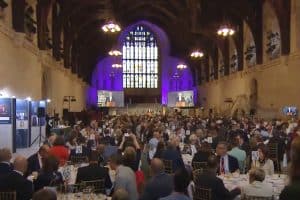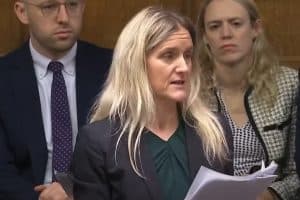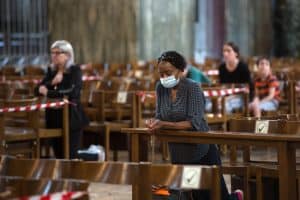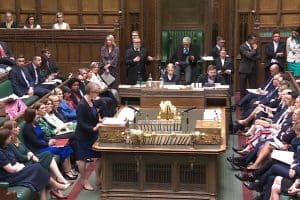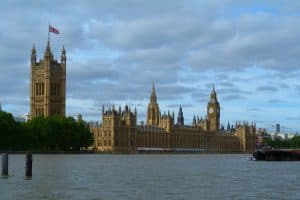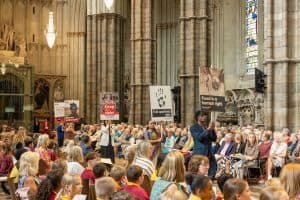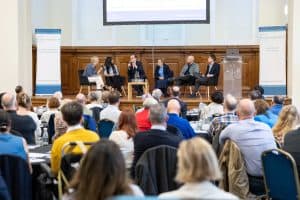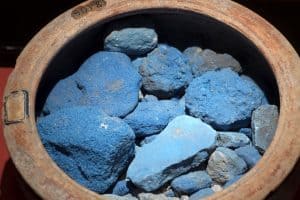By Ruth Peacock
Religion was not just one aspect of the attack on the United States Capitol last year, but rather a thread weaving through the entirety of events, according to the directors of a project cataloguing social media records of the day.
Flags proclaiming “Jesus Saves”, rioters singing hymns, priests and pastors giving interviews while a pagan “QAnon shaman” led prayers from the speaker’s chair illustrated the “diversity and perplexities of American religion” and its relationship to political activity.
Now those thousands of posts have been curated into an online resource, “Uncivil religion: January 6 2021”, a project directed by Dr Michael Altman, associate professor in the department of religious studies at the University of Alabama; and Dr Jerome Copulsky, a consulting scholar at the National Museum of American History’s Center for the Understanding of Religion in American History.
Dr Copulsky told a Religion Media Centre briefing that he was at his desk in Washington DC as the Capitol Hill events unfolded and “it became very clear that this was a political event with a huge religious dimension”. People were wearing religion on their sleeve and there were thousands of images and videos with religious content.
Students at the University of Alabama gathered all the information they could find and the most representative was included in the website. A gallery contains film and stills of crowds, singing, rituals, symbols and documents. A collection of essays, commissioned by the directors, attempts to analyse the significance and meaning of all that occurred.
Dr Altman explained: “I think the people were there for political reasons, but those political goals, reasons and ideas often got expressed through religious discourse, religious practices, religious language, or just songs.”
What became clear was the plurality of the event, Dr Copulsky said. Although the vanguard was Christian nationalism in American protestant evangelicalism, it was not limited to right wing evangelicals. There was a strong Catholic, Jewish and Mormon presence, and “a kind of syncretic religious presence such as the QAnon shaman”.
Many of the images are often reposted and well known, but for Dr Altman three images in the collection were particularly striking. A man dressed as Moroni from the Book of Mormon, illustrating the shift to the right of the Church of Jesus Christ of Latter-day Saints, which was now “very solidly Republican”; the emergence of “Kek”, an alt-right group that began from a meme and is “almost a parody religion”; and the film of a man dressed as George Washington, who carried a Trump flag and marched across the Capitol reflecting pool before addressing the crowds with a megaphone praying that God would save the nation.
That encapsulated the day — nationalism modelled around Trump, with hundreds engaged in the prayer.
The project confirms that the day of insurrection was “religiously incoherent”. Dr Copulsky concludes there was no coherent ideology or religious motivation and the day was peppered with confusions. For example in the Rotunda, the chapel of American democracy with a portrait of George Washington where he is practically deified, the 2021 insurgents sang the Battle Hymn of the Republic, a song defending the union while they were trying to cancel the legal ratification of a democratic vote.
What brought the people together was the political imperative, “the big lie” that Trump had in fact won the election. Dr Altman suggested that in America, political goals are often expressed through religious discourse.
There is a strong attempt, according to Dr Copulsky, to link conservative Christianity and Judaeo-Christian traditions to political groupings. That explains the Jericho march protest including shofars — the trumpets used to herald in the Jewish new year but sounded as an alarm for a regime that was falling.
But other groups joined in. Dr Altman says he was told by a reporter that a group of Chinese American Christians joined with a massive banner saying Trump was anti-communist, and then sold Jesus Saves signs for $10.
It was difficult to say which religious groups were prime movers in organising the rally, march and subsequent insurrection. Dr Altmann said there had been several rallies with Christian leaders such as Eric Metaxas in Washington the day before. But on the day, it was left to a number of self-identifying pastors to be interviewed on camera.
This illustrated the “free flowing” nature of Christian organisation in America, where individuals buy a property, put up a sign, declare themselves pastor, call it a church and that becomes the institution.
Dr Copulsky said America had never had an established church and American religion had always, from its beginning, been full of vibrant democratic tendencies.
Since the 1970s, conservative Christianity, forms of Judaism and Islam and other traditions have become associated with the Republican Party. He said this was due to the policy choices of elites within the Republican Party and in the new religious right. They coalesced around social issues such as abortion, feminism, guns and gay rights.
There were a number of evangelical and Catholic leaders who enjoyed being close to power under Trump, and who were now feeling the loss of their cultural dominance.
But they are not shifting position. Dr Altman said he was not aware of anyone in the Christian traditions who has stood up to Trump and won. Those who have abandoned the “big lie” narrative have been steamrollered and left their church communities to join The Lincoln Project or “hang out with the Episcopalians”.
The base, the Trump supporters buying into the “big lie”, is a “forest that is still pretty dry”. The groups were still there in America and one match could light it again, but Dr Altman could not see an episode that would act as the accelerant.
Dr Copulsky said Trump was still the presumptive nominee for 2024 and gauging support wasn’t just a case of charting followers on the ground. There were a lot of ant-liberal or post-liberal intellectuals in America who saw the Trump presidency presenting a post-liberal democratic vision for the United States. They saw the energies attracted to Trump as fuel for their own political projects.
Would they wrap their vision in religious symbols as at Capitol Hill? In fact, Dr Copulsky explained, their politics is shaped by their religion. Religion has been part and parcel of politics in America from the very beginning.
More than 700 people were arrested after the Capitol insurrection, with charges ranging from obstruction of an official proceeding to assault. Of those, 71 have received criminal sentences, including 31 who were sentenced to periods of incarceration. The rest are awaiting trial or have not yet reached plea agreements.
The so-called “QAnon shaman”, Jacob Chansley, 34, was jailed for 41 months in November after pleading guilty to one felony count of obstructing an official proceeding.
View the media briefing on Uncivil Religion: January 6 2021 below:







